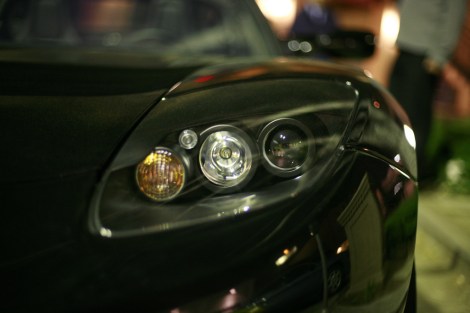Tesla is Silicon Valley’s car. The company’s head of product design, Elon Musk, went from rethinking online payments as a cofounder of PayPal to rethinking automobiles. Tesla’s first vehicle was an electricity-and-testosterone-powered roadster; recently, it added a sedan (electricity only).
Over the weekend, The New York Times ran a review of the sedan by John Broder. His test drive, a haul from the outskirts of D.C. to Boston, could have gone better. From “Stalled Out on Tesla’s Electric Highway”:
The Model S has won multiple car-of-the-year awards and is, many reviews would have you believe, the coolest car on the planet.
What fun, no? Well, no.
The problem was power. The electric car, like a regular car, needs to be refilled. But unlike a regular car, you can’t refuel every few miles. Broder’s trip was meant to highlight two new charging stations between the cities, spaced within the range of a full charge of the car. Ideally. As Broder discovered, that wasn’t his experience — something for which the cold weather may have been partly to blame.
As I crossed into New Jersey …, I noticed that the estimated range was falling faster than miles were accumulating. At 68 miles since recharging, the range had dropped by 85 miles, and a little mental math told me that reaching Milford would be a stretch.
I began following Tesla’s range-maximization guidelines, which meant dispensing with such battery-draining amenities as warming the cabin and keeping up with traffic. I turned the climate control to low — the temperature was still in the 30s — and planted myself in the far right lane with the cruise control set at 54 miles per hour (the speed limit is 65). Buicks and 18-wheelers flew past, their drivers staring at the nail-polish-red wondercar with California dealer plates.
Broder’s trip ended on the back of a flatbed truck in Connecticut. But the story didn’t.
After the review ran, Musk jumped on Twitter to criticize it and the reviewer.
NYTimes article about Tesla range in cold is fake. Vehicle logs tell true story that he didn’t actually charge to max & took a long detour.
— Elon Musk (@elonmusk) February 11, 2013
Tesla blog coming soon detailing what actually happened on Broder’s NYTimes “range test”. Also lining up other journalists to do same drive.
— Elon Musk (@elonmusk) February 11, 2013
Tesla data logging is only turned on with explicit written permission from customers, but after Top Gear BS, we always keep it on for media.
— Elon Musk (@elonmusk) February 11, 2013
The “Top Gear BS” is a reference to a similar problem experienced by the TV show Top Gear when it was reviewing the Tesla Roadster. The show noted that the car ran out of juice well before it should have. Musk and Tesla filed a libel lawsuit, which was eventually thrown out.

Musk’s promised blog post hasn’t yet materialized, but that didn’t stop the Times from rising to the defense of the review. The paper told the Atlantic Wire:
The Times’s Feb. 10 article recounting a reporter’s test drive in a Tesla Model S was completely factual, describing the trip in detail exactly as it occurred. Any suggestion that the account was “fake” is, of course, flatly untrue. Our reporter followed the instructions he was given in multiple conversations with Tesla personnel.
As the San Francisco Chronicle notes, the review did some damage to Tesla. By the time markets closed last night, the stock had dropped 2 percent.
That might be a bit unfair. Tesla got out ahead of its skis a little in suggesting that the car was ready to have a road-trip review even though there are so few charging stations. Limited infrastructure is still a key inhibitor to electric-car adoption. But Musk’s response may have been a worse decision. By attacking the review, he both provides a disincentive to future reviewers and builds the affair into a much bigger deal than it needed to be — though his response did help the stock price rebound a bit. His later tweet indicating that more charging stations are imminent may have made an important longer-term point.
As a Silicon Valley veteran, Musk should know that things go wrong, and it’s the responsibility of the tech company to foresee and handle those problems. And, look, it could have been worse. At least Broder didn’t experience a crash.
Update: Broder posted his own response to Musk. It’s detailed. For example:
Mr. Musk has referred to a “long detour” on my trip. He is apparently referring to a brief stop in Manhattan on my way to Connecticut that, according to Google Maps, added precisely two miles to the overall distance traveled from the Delaware Supercharger to Milford (202 miles with the stop versus 200 miles had I taken the George Washington Bridge instead of the Lincoln Tunnel). At that point, I was already experiencing anxiety about range and had called a Tesla employee from the New Jersey Turnpike to ask how to stretch the battery. She said to shut off the cruise control to take advantage of battery regeneration from occasional braking and slowing down. Based on that advice, I was under the impression that stop-and-go driving at low speeds in the city would help, not hurt, my mileage.
Broder ends his response where we would have thought: It’s worth trying the test drive again once there is more infrastructure.



